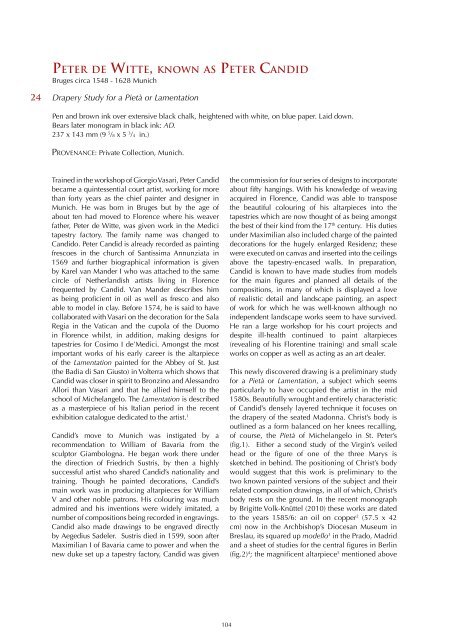Create successful ePaper yourself
Turn your PDF publications into a flip-book with our unique Google optimized e-Paper software.
Peter de Witte, known as Peter Candid<br />
Bruges circa 1548 - 1628 Munich<br />
24<br />
Drapery Study for a Pietà or Lamentation<br />
Pen and brown ink over extensive black chalk, heightened with white, on blue paper. Laid down.<br />
Bears later monogram in black ink: AD.<br />
237 x 143 mm (9 5 /8 x 5 3 /4 in.)<br />
Provenance: Private Collection, Munich.<br />
Trained in the workshop of Giorgio Vasari, Peter Candid<br />
became a quintessential court artist, working for more<br />
than forty years as the chief painter and designer in<br />
Munich. He was born in Bruges but by the age of<br />
about ten had moved to Florence where his weaver<br />
father, Peter de Witte, was given work in the Medici<br />
tapestry factory. The family name was changed to<br />
Candido. Peter Candid is already recorded as painting<br />
frescoes in the church of Santissima Annunziata in<br />
1569 and further biographical information is given<br />
by Karel van Mander I who was attached to the same<br />
circle of Netherlandish artists living in Florence<br />
frequented by Candid. Van Mander describes him<br />
as being proficient in oil as well as fresco and also<br />
able to model in clay. Before 1574, he is said to have<br />
collaborated with Vasari on the decoration for the Sala<br />
Regia in the Vatican and the cupola of the Duomo<br />
in Florence whilst, in addition, making designs for<br />
tapestries for Cosimo I de’Medici. Amongst the most<br />
important works of his early career is the altarpiece<br />
of the Lamentation painted for the Abbey of St. Just<br />
(the Badia di San Giusto) in Volterra which shows that<br />
Candid was closer in spirit to Bronzino and Alessandro<br />
Allori than Vasari and that he allied himself to the<br />
school of Michelangelo. The Lamentation is described<br />
as a masterpiece of his Italian period in the recent<br />
exhibition catalogue dedicated to the artist. 1<br />
Candid’s move to Munich was instigated by a<br />
recommendation to William of Bavaria from the<br />
sculptor Giambologna. He began work there under<br />
the direction of Friedrich Sustris, by then a highly<br />
successful artist who shared Candid’s nationality and<br />
training. Though he painted decorations, Candid’s<br />
main work was in producing altarpieces for William<br />
V and other noble patrons. His colouring was much<br />
admired and his inventions were widely imitated, a<br />
number of compositions being recorded in engravings.<br />
Candid also made drawings to be engraved directly<br />
by Aegedius Sadeler. Sustris died in 1599, soon after<br />
Maximilian I of Bavaria came to power and when the<br />
new duke set up a tapestry factory, Candid was given<br />
the commission for four series of designs to incorporate<br />
about fifty hangings. With his knowledge of weaving<br />
acquired in Florence, Candid was able to transpose<br />
the beautiful colouring of his altarpieces into the<br />
tapestries which are now thought of as being amongst<br />
the best of their kind from the 17 th century. His duties<br />
under Maximilian also included charge of the painted<br />
decorations for the hugely enlarged Residenz; these<br />
were executed on canvas and inserted into the ceilings<br />
above the tapestry-encased walls. In preparation,<br />
Candid is known to have made studies from models<br />
for the main figures and planned all details of the<br />
compositions, in many of which is displayed a love<br />
of realistic detail and landscape painting, an aspect<br />
of work for which he was well-known although no<br />
independent landscape works seem to have survived.<br />
He ran a large workshop for his court projects and<br />
despite ill-health continued to paint altarpieces<br />
(revealing of his Florentine training) and small scale<br />
works on copper as well as acting as an art dealer.<br />
This newly discovered drawing is a preliminary study<br />
for a Pietà or Lamentation, a subject which seems<br />
particularly to have occupied the artist in the mid<br />
1580s. Beautifully wrought and entirely characteristic<br />
of Candid’s densely layered technique it focuses on<br />
the drapery of the seated Madonna. Christ’s body is<br />
outlined as a form balanced on her knees recalling,<br />
of course, the Pietà of Michelangelo in St. Peter’s<br />
(fig.1). Either a second study of the Virgin’s veiled<br />
head or the figure of one of the three Marys is<br />
sketched in behind. The positioning of Christ’s body<br />
would suggest that this work is preliminary to the<br />
two known painted versions of the subject and their<br />
related composition drawings, in all of which, Christ’s<br />
body rests on the ground. In the recent monograph<br />
by Brigitte Volk-Knüttel (2010) these works are dated<br />
to the years 1585/6: an oil on copper 2 (57.5 x 42<br />
cm) now in the Archbishop’s Diocesan Museum in<br />
Breslau, its squared up modello 3 in the Prado, Madrid<br />
and a sheet of studies for the central figures in Berlin<br />
(fig.2) 4 ; the magnificent altarpiece 5 mentioned above<br />
104
















